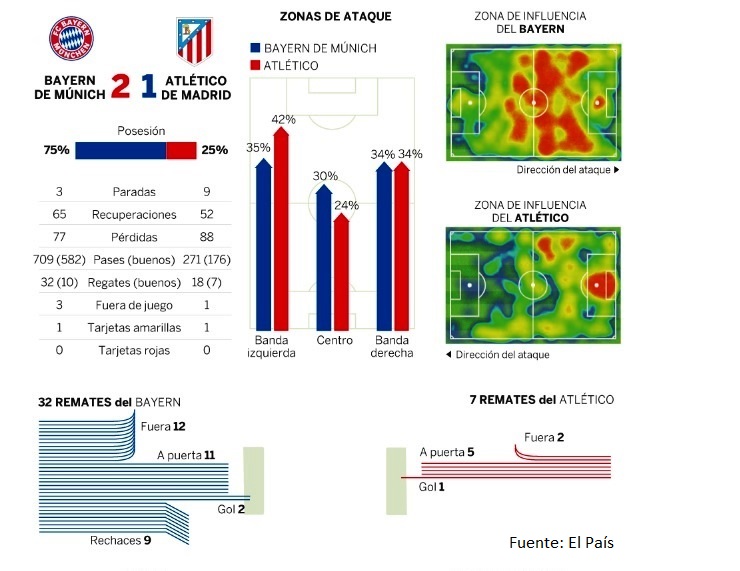
The recent football encounter between Bayern Munich and Atlético Madrid on the 3rd of May 2016 is a good example where we can analyze the importance of infographics and schematics in communication.
If the objective of communication is to transmit knowledge, there are three ways of doing this:
- Having no communication means going without plans or technical tools. It means directly witnessing an event. For example, it could mean being a spectator of the Bayern Munich – Atlético Madrid match on the 3rd of May 2016 in the Allianz Arena in Munich.
- Attending as a TV viewer of the match´s broadcast.
- Press reports after the match.
Primary Findings
- A football match is in itself justified. It is not held to communicate information but instead to get sport, economic and other derived results like fame and success…
- Communication can be produced in cases 2 and 3 with specialized audiovisual and print media intervention, which elaborates and diffuses information.
- While it is clear that the event is a real and concrete, it must always come before the message on the same event, then it is clear that the fact is fundamental so it is only communicable from point where is has existence.
- Case 1: Knowing the facts without communication
Case 1 is psychological and collective. It is an intense live experience with all the excitement and disappointment that involves winning and losing; with all the surprise and immediate experience of what is happening in the field (immediate means “without any media intervention”).
The first characteristic of this experience is that each individual spectator not only participates in the match but also in the context. As we know from semiotics, it is part of the fact. The second characteristic is experiential uniqueness: the “me, here and now”, the uniqueness of the event and therefore the experience of it. However, the psychological dimension of this experience accompanies its statistical dimension, which is determined by the capacity of the Allianz Arena in Munich: 75,000 spectators.
- Case 2: Knowing the facts by being a TV viewer
The second option is watching the match as a TV viewer which is what in theory communication calls “vicarious experience”. That means living through the direct experiences of others: the transmitter, cameras, technicians, sound engineers, commentators, etc.
If there is a psychological loss in respect to case 1, which is about the context, crowd, atmosphere, emotional corruption, etc. It is a reality in the flesh and there are various benefits of this. The first is the possibility of following the match from whatever part of the world without leaving home. As this is mass communication, the number TV viewers (audience) rise by millions.
The second advantage is the technical order: we can record an event and watch it over and over again as much as the person wishes: the me, here and now is, “where I want and when I want”.
- Case 3: Knowing the facts though press reports
If attending a match directly by video occupies time, obtaining another type of communicated information occupies space. It is now about elaborated information from the event; it is the schematic treatment (informative) on the graph paper space or on screen. There are a set of a series of data in a visual format that in fact are information in bits.
This graphic information that we call infographics has the ability to display not only data in graphic synthesis but also, as we can see in the infographics of the newspaper El País, shown above, it realizes the essentiality and specifics of this match in qualitative and quantitative aspects.
It is clear that graphics, diagrams, geometries, silhouettes and color codes provide a complete set of information which has a very different nature from that which comes from watching the match directly or on television.
In conclusion: for the set of reasons and also for the modes in that audiovisual communication and graphics use their languages, complementing and highlighting the most important fact, we can say that communication is stronger than action.
Guest institute: Joan Costa
Joan Costa is the director and creator of the First International Course on Schematics and Infographics. He is a renowned sociologist, communication expert and chairperson of Visual Communication. He coined the term DirCom more than 30 years ago.